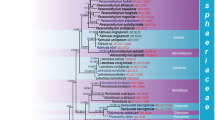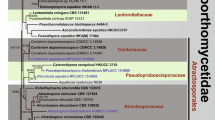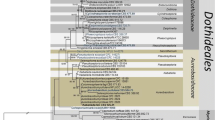Abstract
The Venturiaceae was traditionally assigned to Pleosporales although its diagnostic characters readily distinguish it from other pleosporalean families. These include a parasitic or saprobic lifestyle, occurring on leaves or stems of dicotyledons; small to medium-sized ascomata, often with setae; deliquescing pseudoparaphyses; 8-spored, broadly cylindrical to obclavate asci; 1-septate, yellowish, greenish or pale brown to brown ascospores; and hyphomycetous anamorphs. Phylogenetically, core genera of Venturiaceae form a monophyletic clade within Dothideomycetes, and represent a separate sister lineage from current orders, thus a new order—Venturiales is introduced. A new family, Sympoventuriaceae, is introduced to accommodate taxa of a well-supported subclade within Venturiales, which contains Sympoventuria, Veronaeopsis simplex and Fusicladium-like species. Based on morphology and DNA sequence analysis, eight genera are included in Venturiaceae, viz. Acantharia, Apiosporina (including Dibotryon), Caproventuria, Coleroa, Pseudoparodiella, Metacoleroa, Tyrannosorus and Venturia. Molecular phylogenetic information is lacking for seven genera previously included in Venturiales, namely Arkoola, Atopospora, Botryostroma, Lasiobotrys, Trichodothella, Trichodothis and Rhizogenee and these are discussed, but their inclusion in Venturiaceae is doubtful. Crotone, Gibbera, Lineostroma, Phaeocryptopus, Phragmogibbera, Platychora, Polyrhizon, Rosenscheldiella, Uleodothis and Xenomeris are excluded from Venturiales, and their ordinal placement needs further investigation. Zeuctomorpha is treated as a synonym of Acantharia.














Similar content being viewed by others
References
Barr ME (1968) The Venturiaceae in North America. Can J Bot 46:799–864
Barr ME (1979) A classification of Loculoascomycetes. Mycologia 71:935–957
Beck A, Ritschel A, Schubert K, Braun U, Triebel D (2005) Phylogenetic relationships of the anamorphic genus Fusicladium s. lat. as inferred by ITS nrDNA data. Mycol Progress 4:111–116
Bowen JK, Mesarich CH, Bus VGM, Beresford RM, Plummer KM, Templeton MD (2011) Venturia inaequalis: the causal agent of apple scab. Mol Plant Pathol 12:105–122
Braun U (1998) A monograph of Cercosporella, Ramularia and allied genera (phytopathogenic Hyphomycetes), vol 2. IHW-Verlag, Eching
Braun U, Crous PW, Dugan FM, Groenewald JZ, de Hoog GS (2003) Phylogeny and taxonomy of cladosporium-like hyphomycetes, including Davidiella gen. nov., the teleomorph of Cladosporium s. str. Mycol Progress 2:3–18
Cannon PF, Kirk PM (2007) Fungal families of the world. CABI, Wallingford
Carisse O, Bernier J (2002) Effect of environmental factors on growth, pycnidial production and spore germination of Microsphaeropsis isolates with biocontrol potential against apple scab. Mycol Res 106:1455–1462
Chevenet F, Brun C, Banuls AL, Jacq B, Christen R (2006) TreeDyn: towards dynamic graphics and annotations for analyses of trees. BMC Bioinforma 7:439
Crous PW, Mohammed C, Glen M, Verkley GJM, Groenewald JZ (2007a) Eucalyptus microfungi known from culture. 3. Eucasphaeria and Sympoventuria genera nova, and new species of Furcaspora, Harknessia, Heteroconium and Phacidiella. Fungal Divers 25:19–36
Crous PW, Schubert K, Braun U, de Hoog GS, Hocking AD, Shin H-D, Groenewald JZ (2007b) Opportunistic, human-pathogenic species in the Herpotrichiellaceae are phenotypically similar to saprobic or phytopathogenic species in the Venturiaceae. Stud Mycol 58:185–217
de Gruyter JD, Aveskamp MM, Woudenberg JHC, Verkley GJM, Groenewald JZ, Crous PW (2009) Molecular phylogeny of Phoma and allied anamorph genera: towards a reclassification of the Phoma complex. Mycol Res 113:508–519
Eriksson OE (1981) The families of bitunicate ascomycetes. Opera Bot 60:1–220
Eriksson OE, Hawksworth DL (2003) Saccharicola, a new genus for two Leptosphaeria species on sugar cane. Mycologia 95:426–433
Hall T (2004) Bioedit v7.0.1. Isis Pharmaceuticals
Hanlin RT (1987) Venturia liriodendri sp. nov., associated with a leafspot disease of Liriodendron. Mycologia 79:464–467
Hirayama K, Tanaka K (2011) Taxonomic revision of Lophiostoma and Lophiotrema based on reevaluation of morphological characters and molecular analyses. Mycoscience. doi:10.1007/s10267-011-0126-3
Huelsenbeck JP, Ronquist F (2001) MRBAYES: Bayesian inference of phylogenetic trees. Bioinformatics 17:754–755
Huelsenbeck JP, Ronquist F, Nielsen R, Bollback JP (2001) Bayesian inference of phylogeny and its impact on evolutionary biology. Science 294:2310–2314
Hyde KD, McKenzie EHC, KoKo TW (2011) Towards incorporating anamorphic fungi in a natural classification—checklist and notes for 2010. Mycosphere 2:1–88
Kerr JE (1961) The life history and taxonomic position of Venturia rumicis (Desm.) Wint. Trans Br Mycol Soc 44:465–486
Kodsueb R, Jeewon R, Vijaykrishna D, McKenzie EHC, Lumyong P, Lumyong S, Hyde KD (2006) Systematic revision of Tubeufiaceae based on morphological and molecular data. Fungal Divers 21:105–130
Kruys Å, Eriksson OE, Wedin M (2006) Phylogenetic relationships of coprophilous Pleosporales (Dothideomycetes, Ascomycota), and the classification of some bitunicate taxa of unknown position. Mycol Res 110:527–536
Liew ECY, Aptroot A, Hyde KD (2000) Phylogenetic significance of the pseudoparaphyses in Loculoascomycete taxonomy. Mol Phylogenet Evol 16:392–402
Liu K, Raghavan S, Nelesen S, Linder CR, Warnow T (2009) Rapid and accurate large-scale coestimation of sequence alignments and phylogenetic trees. Science 324:1561–1564
Lumbsch HT, Huhndorf SM (2010) Outline of Ascomycota—2009. Fieldiana Life Earth Sci 1:1–60
Luttrell ES (1973) Loculoascomycetes. In: Ainsworth GC, Sparrow FK, Sussman AS (eds) The fungi, an advanced treatise, vol. 4 A. A taxonomic review with keys: ascomycetes and fungi imperfecti. Academic, New York & London
MacHardy WE (1996) Apple scab: biology, epidemiology, and management. The American Phytopathological Society Press, St. Paul
Menon R (1956) Studies on Venturiaceae on rosaceous plants. Phytopathol Z 27:117–146
Miller MA, Pfeiffer W, Schwartz T (2010) Creating the CIPRES Science Gateway for inference of large phylogenetic trees. In: Proceedings of the Gateway Computing Environments Workshop (GCE), 14 Nov. 2010, New Orleans, LA pp 1–8
Müller E (1958) Systematische Bemerkungen uber einige Venturia-Arten. Sydowia 11:79–92
Müller E, Menon R (1955) Uber Venturia rosae de Not. und die Nomenklatur der Gattung Venturia de not. Phytopathol Z 25:190–195
Müller E, von Arx JA (1950) Einige aspekte zur Systematik pseudosphaerialer Ascomyceten. Ber Schweiz Bot Gesell 60:329–397
Müller E, von Arx JA (1962) Die Gattungen der didymosporen pyrenomyceten. Beitr Krypt Fl Schweiz 11:1–922
Nüesch J (1960) Beitrag zur Kenntnis der weidenbewohnenden Venturiaceae. Phytopathol Z 39:329–360
Olivier C, Berbee ML, Shoemaker RA, Loria R (2000) Molecular phylogenetic support from ribosomal DNA sequences for origin of Helminthosporium from Leptosphaeria-like loculoascomycete ancestors. Mycologia 92:736–746
Pattengale ND, Alipour M, Bininda-Emonds OR, Moret BM, Stamatakis A (2010) How many bootstrap replicates are necessary? J Comput Biol 17:337–354
Petrak F (1950) Beitrage zur Pilzflora von Ekuador. Sydowia 1:169–201
Petrak F (1953) Melanostromella n. gen., eine neue Gattung der Gibberaceen. Sydowia 7:361–363
Petrak F (1954) Ergebnisse einer Revision der Grundtypen verschiedener Gattungen der Askomyzeten und Fungi imperfecti. V Sydowia 8:287–303
Reynolds DR (1991) A phylogeny of fissitunicate ascostromatic fungi. Mycotaxon 42:99–123
Samuels GJ, Rogerson CT (1990) New ascomycetes from the Guayana Highland. Mem N Y Bot Gdn 64:165–183
Schoch CL, Shoemaker RA, Seifert KA, Hambleton S, Spatafora JW, Crous PW (2006) A multigene phylogeny of the Dothideomycetes using four nuclear loci. Mycologia 98:1041–1052
Schoch CL, Crous PW, Groenewald JZ et al (2009) A class-wide phylogenetic assessment of Dothideomycetes. Stud Mycol 64:1–15
Schubert K, Ritschel A, Braun U (2003) A monograph of Fusicladium s. lat. (hyphomycetes). Schlechtendalia 9:1–132
Shenoy BD, Jeewon R, Hyde KD (2007) Impact of DNA sequence−data on the taxonomy of anamorphic fungi. Fungal Divers 26:1−54
Shenoy BD, Jeewon R, Wang H, Amandeep K, Ho WH, Bhat DJ, Crous PW, Hyde KD (2010) Sequence data reveals phylogenetic affinities of fungal anamorphs Bahusutrabeeja, Diplococcium, Natarajania, Paliphora, Polyschema, Rattania and Spadicoides. Fungal Divers 44:161–169
Shoemaker RA (1963) Generic correlations and concepts: Griphosphaerioma and Labridella. Can J Bot 41:1419–1423
Silva-Hanlin DMW, Hanlin RT (1999) Small subunit ribosomal RNA gene phylogeny of several loculoascomycetes and its taxonomic implications. Mycol Res 103:153–160
Singer R, Gamundi IJ (1963) Paraphyses. Taxon 12:147–150
Sivanesan A (1977) The taxonomy and pathology of Venturia species. Lubrecht & Cramer Ltd, Vaduz
Sivanesan A (1984a) The bitunicate ascomycetes and their anamorphs. J. Cramer, Vaduz
Sivanesan A (1984b) Acantharia, Gibbera and their anamorphs. Trans Br Mycol Soc 82:507–529
Stamatakis A (2006) RAxML-VI-HPC: maximum likelihood-based phylogenetic analyses with thousands of taxa and mixed models. Bioinformatics 22:2688–2690
Stamatakis A, Hoover P, Rougemont J (2008) A rapid bootstrap algorithm for the RAxML web servers. Sys Bio 57:758–771
Sultan A, Johnston PR, Park D, Robertson AW (2011) Two new pathogenic ascomycetes in Guignardia and Rosenscheldiella on New Zealand’s pygmy mistletoes (Korthalsella: Viscaceae). Stud Mycol 68:237–247
Swart HJ (1988) Australian leaf-inhabiting fungi. XXIX. Some ascomycetes on Banksia. Trans Br Mycol Soc 91:453–465
Talbot PHB (1971) Principles of fungal taxonomy. St. Martin’s, New York
Tamura K, Peterson D, Peterson N, Stecher G, Nei M, Kumar S (2011) MEGA5: Molecular Evolutionary Genetics Analysis using maximum likelihood, evolutionary distance, and maximum parsimony methods. Mol Biol Evol. doi:10.1093/molbev/msr121
Untereiner WA, Straus NA, Malloch D (1995) A molecular-morphotaxonomic approach to the systematics of the Herpotrichiellaceae and allied black yeasts. Mycol Res 99:897–913
von Arx JA (1952) Studies on Venturia and related genera. Tijdschr Plantenz 58:260–266
von Arx JA (1954) Revision einiger Gattungen der Ascomyceten. Acta Botan Neerl 3:83–93
von Arx JA, Müller E (1975) A re-evaluation of the bitunicate ascomycetes with keys to families and genera. Stud Mycol 9:1–159
Walker J, Stovold GE (1986) Arkoola nigra gen. et sp. nov. (Venturiaceae) causing black leaf blight of soybean in Australia. Trans Br Mycol Soc 87:23–44
Winton LM, Stone JK, Hansen EM, Shoemaker RA (2007) The systematic position of Phaeocryptopus gaeumannii. Mycologia 99:240–252
Wu HX, Jaklitsch WM, Voglmayr H, Hyde KD (2011a) Epitypification, morphology and phylogeny of Tothia fuscella. Mycotaxon 118: in press
Wu HX, Schoch CL, Boonmee S, Bahkali AH, Chomnunti P, Hyde KD (2011b) A reappraisal of Microthyriaceae. Fungal Divers 52: in press
Zhang Y, Wang HK, Fournier J, Crous PW, Jeewon R, Pointing SB, Hyde KD (2009) Towards a phylogenetic clarification of Lophiostoma/Massarina and morphologically similar genera in the Pleosporales. Fungal Divers 38:225–251
Zhang Y, Crous PW, Schoch CL, Hyde KD (2012) Pleosporales. Fungal Divers 1–221. doi:10.1007/s13225-011-0117-x
Acknowledgements
Ying Zhang would like to thank the Mushroom Research Foundation, Chiang Mai, Thailand for providing her with a post doctoral fellowship for this study. We are grateful to the Directors and Curators of NY, K, L, PH, S for the loan of specimens in their keeping. E.H.C. McKenzie is thanked for his comments on an earlier version of the script. This work was supported by Thailand Research Fund BRG528002. The Global Research Network for Fungal Biology and King Saud University are also thanked for support. Conrad L. Schoch acknowledges support by the Intramural Research Program of the NIH, National Library of Medicine.
Author information
Authors and Affiliations
Corresponding author
Rights and permissions
About this article
Cite this article
Zhang, Y., Crous, P.W., Schoch, C.L. et al. A molecular, morphological and ecological re-appraisal of Venturiales―a new order of Dothideomycetes . Fungal Diversity 51, 249–277 (2011). https://doi.org/10.1007/s13225-011-0141-x
Received:
Accepted:
Published:
Issue Date:
DOI: https://doi.org/10.1007/s13225-011-0141-x




